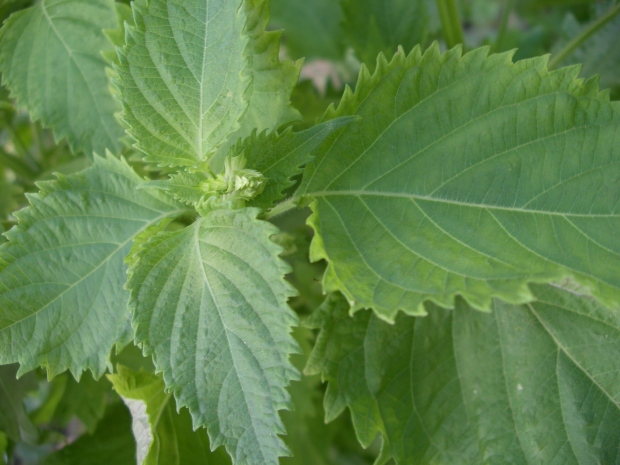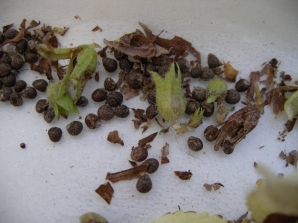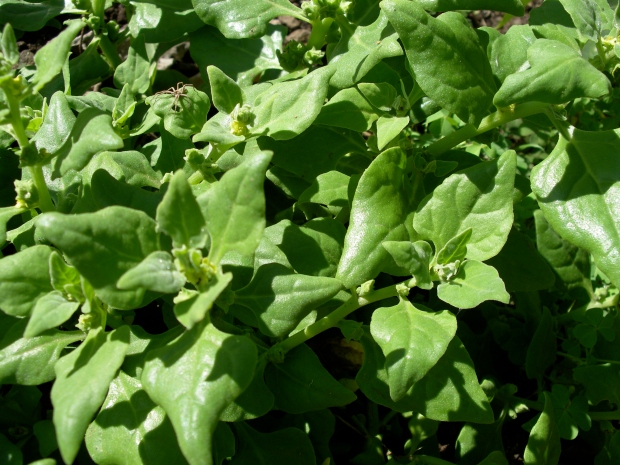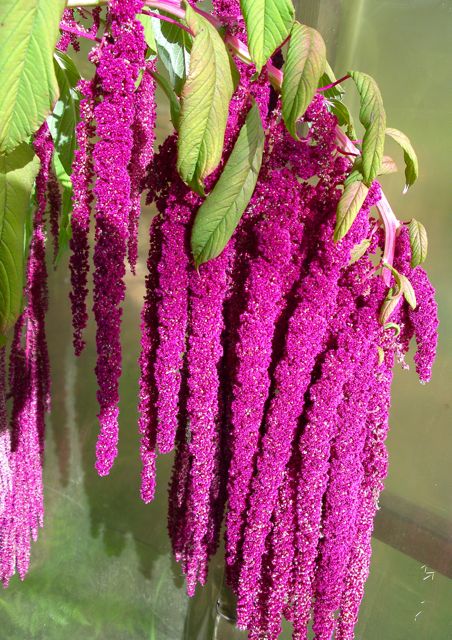Archive for category Perennials & Self-seeders
Perilla (Shiso)
Posted by Laura Hudson in A-Z Edibles, Herbs, Leaves & Salad, Perennials & Self-seeders on June 2, 2013
Tender Self-Seeding leafy herb
Also known as Shiso or beefsteak plant. Perilla is a member of the Lamiaceae family, which includes many strong aromatic herbs including; mint, basil, rosemary, lavender, Melissa, marjoram and sage. This tender bushy herb is grown for its aromatic leaves, flower buds and seeds. Used extensively in East Asia as a vegetable and as a herb it makes a great addition to a kitchen or herb garden.
History The plant is native to South East and East Asia.
Site & Soil Warm, light well-drained soil. Prefers acid soils of PH 5.5 -6. Seems to grow on any soil and does not require rich soil. Best grown in full sun or partial shade in mild climates. Perilla will happily grow in pots and borders. In warm temperate climates perilla will freely self-seed and can be invasive.
Propagation Seeds require light to germinate and should have no or little covering of soil when sowing, but keep soil moist during the germination. To increase prospects of germination soak seeds overnight before sowing. Sow in situ or in trays at 15-20°C 30-40 days before last frost and plant out when all risk of frost has passed.
Sow (March) April-June Spacing 30cm apart Harvest All summer
Care The growing points can be nipped out to keep the plants sturdy. Warm temperatures, long day length and adequate moisture are required for good vegetative growth, and short days for flower production.
Spread Stands around 3ft tall.
Harvest The flavour is best when the leaves are picked about 5cm wide.
Storage Store fresh in a salad chiller for several days. Leaves can be pickled or dried for longer storage.
Botany and Seed Saving Plants are propagated by seed they flower and seed in late summer-autumn viability of seed is reduced after one year at room temperature but can be kept longer if kept under 5c. Some sources state that the seed can lie dormant for 1-2 years but that a period of 1-2 months in cold will re-activate the seeds, which might explain why it self-seeds so well, the seeds are happy to survive cold winters to germinate the following spring.
Use Leaves are often served whole as decoration and are to be eaten wrapped around raw fish or cooked foods on the plate. Fresh leaves can be used to wrap meats or stuffing mixes into parcels or rolls before cooking. The leaves are often shredded and served in salads with cucumber, cabbage or radish or as garnishes or flavouring for beef, eggs, potatoes, rice etc. The leaves can be used as a vegetable; braised or fried in oil with garlic or ginger in a wok or added to soups, they are also battered and served Tempura style then added to soups. Shiso leaves are a principal ingredient in shiso maki (rice and perilla wrapped in seaweed). The seeds can be salted and pickled and are ground, often added to the famous seven spices of Japan, Shichimi. The red varieties are used as colouring and for flavouring pickles such as sour plums and ginger. Leaves can be pickled by steaming for 10 minutes then covering in a mixture of soy sauce and vinegar. Leaves are also dried and sprinkled on rice. Miniature seedlings (sprouted seeds) can be used as a tasty garnish or micro green.
Recipes Pork Shiso Parcels
Other Properties has anti-inflammatory properties and is thought to help preserve and sterilize other foods.
Varieties Botanist consider the red and green types to be different. Red Shiso akajiso in Japanese is used to dye umeboshi pickled plums. While the green shiso aojiso is the stronger flavoured of the two Korean Shiso is distinct from Japanese perilla the leaf appearance is different larger, rounder, flatter, with a less serrated edge, and often a violet coloring on the reverse side and the flavour is more reminiscent of apples and mint
My Growing Notes Freely self-seeds and does better than Basil in a hot or shady garden. I have not yet grown Perilla in England but I am about to sow some seeds so I would love to hear from anyone who has grown it in the UK.
Reference http://web.archive.org/web/20030608171945/http://www.crop.cri.nz/psp/broadshe/perilla.htm
http://www.hort.purdue.edu/newcrop/proceedings1993/V2-322.html#Volatile%20Oil
Brenner, D.M. 1993. Perilla: Botany, uses and genetic resources. p. 322-328. In: J. Janick and J.E. Simon (eds.), New crops. Wiley, New York.
Asparagus
Posted by Laura Hudson in A-Z Edibles, Perennials & Self-seeders on April 19, 2012
Asparagus, Asparagus Officinalis, a hardy perennial from the Liliaceae family. Asparagus is an ancient vegetable highly prized for its wonderful flavour as well as its nutritional and medicinal values, it produces tasty edible spears in mid spring. Asparagus may seem like a lot of work and a long wait to get started but once the plants have settled in and the asparagus bed has started producing it can’t be beaten, it really is worth taking the time and making the space for it.
History
Asparagus is believed to be a native of the Mediterranean lands but it has been found “wild” in so many places that there is some confusion as to where it actually originated. There are references to asparagus in ancient Egypt, Greece, Syria and Spain. It is known to have been cultivated by the Romans since at least 200 B.C. but it was not until the 16th century that it became popular in France and England. From there the early colonists took it to America.
Site & Soil
Asparagus is best in full sun in an open site but not too exposed to wind. It requires rich, (low nitrogen) well-drained, sandy soil and prefers a PH of between 6.5 – 7.5. Asparagus grows best at 16-24c but needs cool winters during its dormant period to crop well in spring. The natural habitat of Asparagus is maritime and it can be found growing wild in many seaside locations around the world. It thrives in soils that are too saline for many other plants and is an ideal plant for a seaside garden.
Preparation (asparagus trench)
Incorporate a good amount of manure before planting. (preferably in autumn leaving the soil rough until March). In March dig a trench 20cm deep and 30cm wide. If soil was not prepared beforehand incorporate manure and leaf mould. Shape soil at the bottom of the trench into a ridge 10cm high running the entire length of the trench and sprinkle with bone meal. Trials have shown that adding sheep manure, bone or wool to the very bottom of the trench ensures a slow release of nutrients over a long period and will benefit asparagus. We happened to have all of the above from the late sheep that roamed the mountain so they went into my trenches.
Propagation
- by division – divide roots in late winter or early spring when buds are just developing and before new root growth begins in earnest. Carefully lift crown with a fork. Shake off excess soil. Cut away any damaged or diseased growth from each section. Take great care not to damage or cut into any buds. Pries apart the crown into sections each with at least one good bud. If necessary gently cut through the Crown. Place crowns 60cm (some say 30-45cm) in a single bed or in beds with 2-3 rows 60-90cm apart. Lay crowns upon the prepared ridges spreading the roots down either side. Gently fill in the trench with sifted soil so that : only the buds are visible. Earth up as the asparagus grows to always keep the same amount of stem uncovered. By autumn the trench should be filled In warmer climates cover the bud tips with 5cm of loose soil to stop them drying out.
- by seed – Sow seeds in a seed bed 2.5cm deep and 8cm apart in rows 30cm apart. Transplant the largest as crowns to their permanent position the following spring (see above). Alternatively sow in modules in late winter – early spring (13-16c) and transplant in early summer ready to harvest after 2 years. TIP Soak seeds 2 days before sowing.
Care
An asparagus bed will provide spears for 15-30 years if well maintained so it is worth taking care of your beds. The roots store the energy produced by ferny stems during the growing season. Once harvested Asparagus should be left to grow ferns and be kept weeded, watered and fed so that a fresh crop of spears can be produced next year. Keep asparagus beds weed free and moist. Do not let the beds dry out or get water-logged. After spring harvesting apply a general fertiliser or seaweed based meal to nurture stem growth and build up plants for the following year. In autumn cut down the ferny stems once they have turned yellow (burn to avoid harbouring asparagus beetle eggs). Stumps should be left 3-4cm proud. Apply a heavy top-dressing of well-rotted manure in Autumn to late winter or cover beds in seaweed. Remove in spring if the seaweed has not rotted down. Feed again with fish meal, chicken dung, seaweed and add a sprinkling of salt in Spring.
Harvest
It will normally take 3 years to crop from seed, but crowns can be bought at 1 or 2 years old which will crop in 1-2 years. Asparagus is ready to harvest once the spears reach 10-17cm long. Cut them obliquely about 2.5-5cm below the surface with a sharp knife or serrated asparagus blade. Harvest period is 6- 8weeks but do not harvest after midsummer as this will result in weaker spears next year. Our Asparagus season starts with the first spears in the first week of April and continues through to mid May at which point I stop cutting the spears to allow the plants time to grow a last flush of spears that will turn into ferns.
Storage & Culinary
Asparagus is such a delicious vegetable that when it arrives you just want to eat it as fresh as possible. It is said that the water should be put on to boil before cutting the asparagus, so that the fresh spears can be dropped straight into the boiling water. Asparagus is also delicious stir fried, grilled over hot coals, in salads or made into a light soup. In ancient times asparagus was dried to be eaten over the winter nowadays we can freeze it.
Nutrition
Asparagus is a wonder plant nutritionally. It is high in Folic Acid and is a good source of potassium, fiber, vitamin B6, vitamins A and C, and thiamin. It is the best vegetable provider of folic acid, necessary for blood cell formation and growth, as well as liver disease prevention. Asparagus has no Fat, contains no Cholesterol, is low in Sodium and is low in calories, each spear contains less than 4.
Companion
Asparagus grows well with Tomatoes, Parsley and Basil. I have found that growing New Zealand Spinach between the raised beds works well by allowing it to creep over the beds it helps retain moisture in the beds during the hot summer months. The light shade cast by asparagus ferns in the summer months could also be used to benefit other plants such as lettuces and spinach which struggle in the heat.
MDD Growing log
When we arrived at Mas du Diable in early winter I discovered a few straggly asparagus ferns growing in the orchard. I thought they were wild asparagus but it turned out these plants were the remains of an asparagus bed that had been planted around 15 years before. After resuscitating the old crowns we still needed more so the plan is to grow the rest from seed and aim for a bed of at least 30 crowns.
2004 In spring I dug the asparagus up just as the buds were emerging, dividing it carefully into 10 crowns and started our first asparagus bed in the veg patch. I left all the spears without cutting to turn into ferns. By autumn the ferns looked healthier than they had, abandoned in the orchard, but definitely needed beefing up. The beds were top dressed with seaweed meal and compost.
2005 Each of the found crowns produced perhaps 5 or sow thin spears which we cut to eat until the beginning of June then left the plant to grow ferns. The ferns looked big and strong and an improvement on the previous year.
2006 We sowed Jersey Knight Improved (10 seeds from T&M) individually in pots in a heated propagator in January, 6 germinated. I set out the plants in a protected seed-bed, uncovered cold frame, in April where they grew well. Meanwhile the found crowns provided a decent harvest and have produced huge ferns which I hope means a better still crop next year.
2007 I have another more generous packed of Argenteuil (350 seeds from Franchi) to try which i plan to sow 1/4 in January and then again in March as the seed packet recommends March to the end of June.
2008 The beds are now well established and produce a good crop sometimes as early as February and I always follow the rule of not cutting beyond the summer solstice.
Tetragon
Posted by Laura Hudson in A-Z Edibles, Leaves & Salad, Perennials & Self-seeders on April 6, 2010
Also known as New Zealand Spinach, Tetragonia tetragonioides, from the Tetragoniaceae family formerly classified with Aizoaceae (ice plant). Tetragon is a half-hardy perennial originating in temperate, subtropical and coastal regions of the Southern Hemisphere. It is a quick-growing leafy vegetable with succulent like leaves and a low spreading habit, often over several feet, which can be left to spread or can apparently be trained to grow over trellising though I have not tried that myself. I prefer to grow it as an edible ground cover crop and I think it is a good choice for forest and perennial gardeners. A useful edible in warm climates as it can stand heat and dry conditions without bolting.
Half-Hardy self-seeding annual leafy edible plant
History An heirloom leafy vegetable that was a popular among the Maori people of New Zealand and first brought to Europe by Joseph Banks in 1771 on his return aboard the Endeavour with Captain Cook.
Site & Soil Prefers a sunny site sheltered from frost with well-drained, sandy soil rich in organic matter and a PH range of 6.8-7. It is a resilient crop tolerant of very poor soils, high temperatures and maritime exposures but not of frost. Add well-rotted compost to the top 15cm of the soil before sowing.
Propagation Sow 1-2cm deep in fine soil and keep moist until seedlings emerge.
1. Sow directly in mid-late spring after the last frost.
2. Sow undercover and set out when 5cm high when all danger of frost has past.
Germination can be slow; soaking the seeds for 24hrs before sowing will help break down the hard outer coating of the seed. Germinates 7-21 days. Crops in 50-70 days
Timing Sow (March-April) May Harvest July-Oct
Care Tetragon needs very little care. Pinch out the growing tips to encourage bushy growth. Hoe to keep weeds down during seedling stage after that the foliage will act as a ground cover and suppress weeds. Water in very dry weather.
Pests & Diseases Tetragon is relatively pest free; slugs and snails don’t even seem to bother it.
Harvest Regular picking promotes new growth and plants can be cut down near to ground level and still re-grow.
Spread 120cm
Storage Will store for several days wrapped in paper in a salad drawer.
Botany and Seed Saving Seeds are very easy to collect. Flowers are produced at leaf axis along the growing stem leaving green buds with small spikes once these buds start to turn brown they are ready to harvest. Finish drying the seeds and store in a paper bags in cool temperatures. Be careful to harvest all the seeds before they drop, unless you want to start a self-seeding bed, as Tetragon is very good at propagating itself. Seed Life 50% germination for 5 years.
Use The tips and young leaves are used in place of spinach or other leafy greens. A particularly useful crop in hot dry areas or in summer when few other delicate greens will grow. In France Tetragon is used to make a quiche like tart with the boiled greens mashed up with egg, nutmeg and Crème fraîche and baked in a pastry shell. It is also steamed or boiled and drizzled with olive oil.
Nutrition Tetragon is high in Vitamins A, B1, B2 and C.
Varieties I have so far not come across any named varieties
Amaranth
Posted by Laura Hudson in A-Z Edibles, Cooking Greens, Grains & Seeds, Leaves & Salad, Perennials & Self-seeders on April 3, 2010
A tender annual of the Amaranthaceae family, Amaranth is grown for its protein rich leaves as well as it nutritious grains. The name Amaranthus is said to come from the ancient Greek meaning ‘life-everlasting’ which probably refers to its habit of self-seeding. It is also known as Indian, African or Chinese spinach or sometimes as calaloo. This plant has everything going for it, it is easy to propagate, doesn’t much care where you put it, produces an abundance of fresh leaves to eat in summer and delicious nutty grains in autumn, it tastes great and is versatile in the kitchen and if that wasn’t enough it is one of the best looking plants you can grow in an edible garden. I got my seeds a few years back from Bob Bester in Tazmania and although there are many varieties of Amaranth I think this one is Amaranthus caudatus.

Plant History Its origins appear to be widespread; it is known to have been grown in Asia since the beginning of recorded history, there are species native to Africa and it was a fundamental food and cultural crop of the South Americas. Amaranth is an ancient crop that, along with beans and corn, was famously one of the main foods of the Aztecs. With the arrival of the Spanish conquistadors and the collapse of Indian cultures Amaranth survived only in small pockets of cultivation in scattered mountain areas. Today grain amaranth is a forgotten crop, while corn and beans became two of the leading crops that feed the world, amaranth faded into obscurity despite its potential as a global food source. Amaranth is still grown and eaten as a vegetable green in over 50 tropical countries and is a vital crop in some of the harshest growing conditions in the world.
Site and Soil Tolerates heat and drought as well as some shade. Grows vigorously and adapts well to various sites.
Propagation Very quick to crop the first young leaves can be picked in as little as 3 weeks. Sow Spring (April-May) a second crop can sown again in late summer in warm areas. Sow in trays and plant out after last frost or sow direct. Cover seeds only lightly or not at all. Germination aprox. 8-10 days at 21-24c (70-75F)
Care it seems to take care of itself and is a really easy plant to grow. It would make a good choice for low maintenance, permaculture or forest gardens as well as a kitchen garden or even flower garden.
Harvest young leaves in summer and grains in the autumn. The grains are inside the millions of tiny pink flowers, dry and shake to extract the seeds.
Storage use leaves freshly picked or blanch and freeze to store. The dry grains will store for several years.
Botany and Seed Saving [1]A pioneer species, whose niche in nature is the quick colonisation of disturbed land. Plants  produce a huge number of fast germinating seeds and use the C4 photosynthetic mechanism, common in arid-land species, which enables them to thrive in hot, dry weather.
produce a huge number of fast germinating seeds and use the C4 photosynthetic mechanism, common in arid-land species, which enables them to thrive in hot, dry weather.
Use Amaranth leaves are used as a ‘potherb’ boiled and eaten as vegetable greens. The stems and leaves cook quickly and become soft with a mild flavour and no trace of bitterness or squeekiness. The leaves and stems make wonderful stir-fries and, to my taste, a far superior cooking green to spinach, particularly when cooked oriental style. The grains can apparently be used in breads, breakfast cereals or as an ingredient in confections but I’ve been experimenting with them in the kitchen making the most wonderful savory seedy biscuits to eat with cheese.
Nutrition [2] Amaranth produces a gluten free high protein grain and the leaves are high in calcium and iron and vitamins C and A making it a valuable source of food.
Bibliog and further reading
[1] Lost Crops of Africa: Amaranth
[2] Amaranth Modern Prospects for an Ancient Crop








